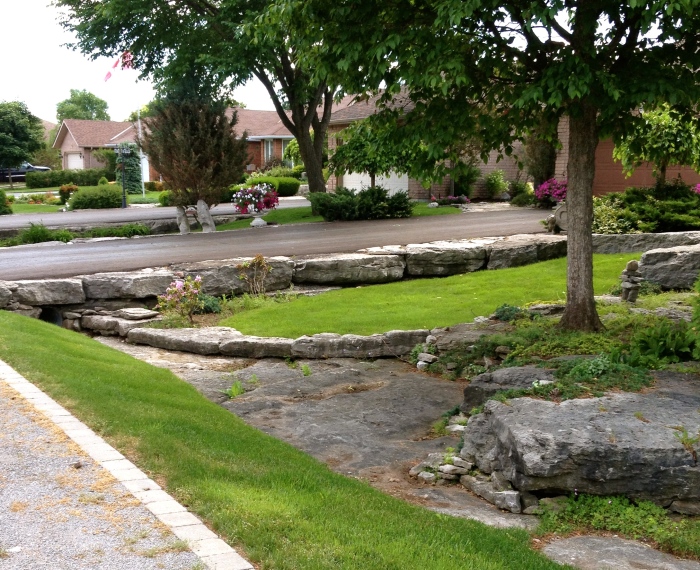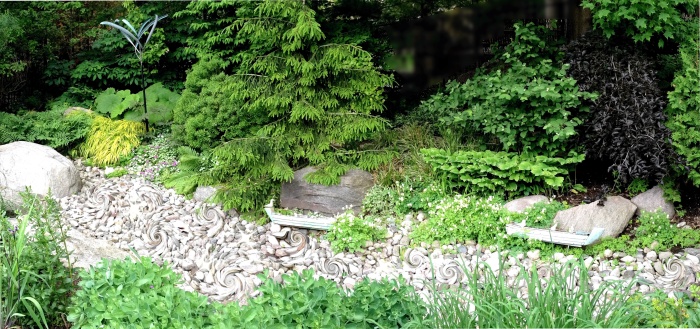In your own garden, reality isn’t the point. I think it’s more about making your own version of relaxing and beautiful and meaningful. Take dry creeks, for instance. They are so not a creek and yet they can convey a powerful sense of flowing water. And you can put one just about anywhere, even in a spot Mother Nature wouldn’t have chosen in her wildest dreams.

Who needs water when a water feature only really needs the idea of water, like this dry pond complete with larger boulders framing the edges and some fun maritime-ish sculptures.
Where’s the udder?
I once took a painting workshop led by a very talented professional fine artist who would ask his befuddled students “Where’s the udder?” whenever we were struggling with a shape that should’ve been a tree or a cloud but, despite our best efforts, remained an undistinguished blob. He was referring to his observation that drawing a stick figure of an animal is easy: a circle for the head, a bigger circle for the body, then four sticks for legs and another for a tail. But anyone looking at it wouldn’t know whether your drawing was of a cat or a dog or a horse. But, add a semicircle to the tummy of your stick animal and finish it off with a few little lines poking out of that bump and voila! You have an immediately recognizable cow thanks to the addition of your cartoon udder. So, if you want to paint clouds scudding across the far horizon, and you don’t want them to look like funny white blobs, make them instantly recognizable by adding that one distinct feature all distant clouds have–a flat bottom.
The same can be said for a dry creek. Your landscaping project could be nothing more than a shallow dip in the terrain filled with rocks or mulch. But add a little bridge and suddenly you’ve got a river running through your garden. I love the bridge shown in these two photos below because the bridge itself is a very simple design but instantly reminds you of a pier. The irises aren’t wading in water but their reed-like leaves make you think you’re crossing a marsh.
Ditch the ditch
Ditches have terrific potential as a water feature, too, even if they hardly ever fill with water. Especially if they hardly ever fill with water. Clearing the ditch of turf and/or weeds and lining the bottom with stones can give you that instant creek look while the stones and any plants you add can help reduce the amount of siltation (from erosion) and pollution (from excessive use of fertilizers, for instance) that enters the public sewer system. If you’re thinking about going farther and turning your ditch into a rain garden, keep in mind that successful rain gardens need the room (width and depth) to maintain the right plants and drain effectively. If the garden doesn’t drain properly, you’ve got a bog garden and that’s a whole other can of worms. If your ditch is too close to the road, you may have to rethink the location of it to protect the integrity of the road’s structure. Check out Rain Garden Design Templates from the Low Impact Development Centre for a good overview of rain gardens. You’ll find extensive plant lists there, too.

Here’s a great example of that old if-you’ve-got-lemons-make-lemonade game plan. This front garden in Bobcaygeon, Ontario, takes full advantage of the fact that the topsoil in this area is naturally very shallow, laying on top of massive slabs of rock.
Building on the dry creek idea
When I visited Keppel Croft Gardens, on the west side of the Bruce Peninsula in Southern Ontario, I was amazed by how lots and lots of small rocks were used so imaginatively and effectively. (Given that most of the topsoil was scraped away in the last Ice Age, local farmers and gardeners tend to admit that rocks are the easiest thing to grow in these parts.) One of the first large features you see as you enter the gardens is a spectacular dry creek that meanders and pools just like the watery kind with small, smooth stones mimicking the texture of a rippling stream. This feeling of flowing water is felt in other parts of the gardens, too. Small rocks and flat stones are used as mulch to conserve moisture in the garden beds but they also create an uncanny sense of movement. Without dark dirt to anchor them to the ground, the long, undulating shapes of these flower beds are thrown into relief and every square inch that’s not covered by a plant shimmers under the strong summer sun. Pebble lined pathways have the same effect. Are you following a stone pathway or navigating from stepping stone to stepping stone as you make your way upstream? The reality is that you don’t have to decide.








I love how rocks of all kinds offset and enhance the living parts of a garden. Reading this made me want to go outside and play!
LikeLike
I guess dry creeks make rocks come alive.
LikeLiked by 1 person
Whenever I see a dry creek bed I feel so frustrated that I don’t have room for one in my front garden. Or do I?
LikeLike
I love rocks and have made three small dry creek beds where an overflow of rain water runs. 🙂 These examples you showed are lovely.
LikeLike
Thanks! I think dry creeks can solve so many garden design problems and they really are easy to create.
LikeLiked by 1 person